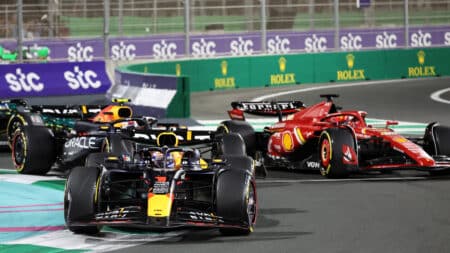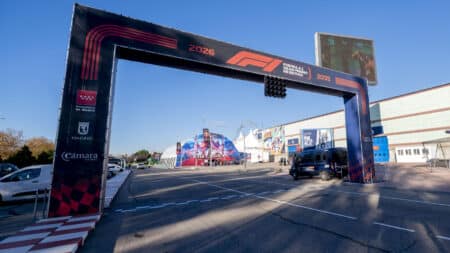
Which Red Bull will show up in Jeddah? - What to watch for at Saudi GP
Can Red Bull rebound from its poor Bahrain showing? And will it be Piastri or Norris leading McLaren's charge? Here's the five themes to watch for at the Saudi Arabian GP
Sebastian Vettel’s victory this weekend was not the first time Ferrari has unexpectedly beaten a dominant Mercedes-Benz racing team, but it was the first I can recall in which Ferrari conquered the might of Mercedes from so far back.
It was an extraordinary achievement, a win apparently on pure pace from a team coming off the back of one of the very worst seasons in its illustrious history. Indeed I rather wish Vettel had not benefitted from the clever call not to pit under the safety car, because I think he’d have still won and removed any doubt about the merit of that victory.
For parallels from history you can look back to 1954 and observe that José Froilán González and Mike Hawthorn were there to mop up on the rare occasions the W196s faltered, but then Ferrari had dominated Grand Prix racing like few other teams for the previous two seasons. In the 1955 World Championship Ferrari won just once at Monaco, not because Trintignant’s 625 suddenly found the legs to beat the Benz, but because of freak engine failures sidelining both Fangio and Moss.

But there was a race Scuderia Ferrari would have been less fancied to win even than Malaysia last weekend, and yet against all the odds and thanks to the unique skills of one man, came through to beat a Mercedes team perhaps even more formidable than that of today. And this year marks its 80th anniversary.
In 1935 the Scuderia was of course not making its own cars, but running the works Alfa Romeo racing team. And what a thankless task it must have been. Its Tipo B race car (often erroneously referred to as the P3) was not only ancient, but conceived before new rules for 1934 had made Grand Prix racing far more exciting than the authorities ever intended.
By mandating a maximum 750kg weight limit but providing no cap on engine size or configuration, the perfect environment for the most fertile engineering minds – such as that of Professor Ferdinand Porsche – was created. So spectacularly did the law of unintended consequences come into play that a formula originally thought capable of restricting cars to around 200bhp and 140mph (because bigger, more powerful engines would broach the weight limit) within three years created machines with better than 600bhp, capable of over 200mph.

Even by 1935, just the second year of the new formula, the power outputs of the V16 Type B Auto Unions and straight eight W25 Mercedes were nudging 400bhp. They had independent suspension, five speed gearboxes and a power advantage over the live axle, leaf sprung, four speed Tipo B of at least 100bhp. For the home teams lining up on the hallowed soil of the Nürburgring, the 1935 German Grand Prix was looking like a turkey shoot.
Three of Ferrari’s Alfas lined up against nine entries from the German teams – five from Mercedes, four for Auto Union. The driver line ups were no less dazzling: for Mercedes came Caracciola, Fagioli, von Brauchitsch and Lang, for Auto Union Rosemeyer, Stuck and Varzi. Ferrari had Chiron, Brivio and, of course, Tazio Nuvolari. Aged 43 he was – and by some margin – older than any of the German team drivers.
Race day dawned for the teams and 250,000 spectators under leaden skies and pouring rain, which only stopped just before the start.
The grid was decided by lottery with Nuvolari fortunate to be in the middle of the front row, though this mattered little because at the flag fall it was Caracciola’s monstrous W25 starting from seventh place that streaked into the lead. By the end of the first lap he was 12 seconds clear of Nuvolari, the only non-German car in the top five. A lap later Nuvolari was fifth having spun at Bergwerk, over 40 seconds off the lead, and by lap four the gap was over a minute. By lap six both other Alfas were out, leaving Nuvolari’s as Ferrari’s last, a scarlet, aged blob of hope, set adrift in a raging, rampant sea of silver.

Which appears to be just the kind of challenge he was after. By lap seven he was third and somewhat improbably given the raw material at his disposal, the fastest car on circuit. On lap nine third became second behind Caracciola, with Nuvolari the only driver on the track to lap in under 11 minutes, and a barely believable 28 seconds quicker than Caracciola. On lap 10 he took the lead to the incredulity of the crowd, the home teams and the multitude of Nazi officials there to milk what had appeared to be an inevitable German victory.
But then came the pitstops, which Ferrari’s men bungled by breaking the refuelling pump. By the time Nuvolari had hopped out, shouted at a few people and the car refilled using churns, he’d lost 2min 14sec, almost 1min 30sec more than the quickest of the Mercedes. He rejoined, his lead a distant memory, down in sixth place.
Not that that deterred him in the least. Indeed he simply dug deeper and started passing car after car. Rosemeyer had to pit but he got past both Stuck and Caracciola on merit, a bizarre feat for such an old and underpowered car. But in the lead was von Brauchitsch, driving faster than ever, and a force surely not even Nuvolari could conquer. On lap 15 the gap was more than 90 seconds, but if it was unbridgeable, no-one had told Nuvolari, who somehow managed to tear huge chunks from it, lap after lap. By lap 17 it was down to 73 seconds; one lap later it was 47.

But warned by his pit of the impending danger, von Brauchitsch woke up and starting lapping faster than ever, even though his tyres were in a terrible state. With one lap to go the gap was 35 seconds. If von Brauchitsch pitted for fresh rubber second place was the best he could hope for. Mercedes team manager Alfred Neubauer saw two routes, one that led to possible victory, the other to certain defeat and made the same decision I imagine we all would in such circumstances. Von Brauchitsch stayed out while Germany held her breath.
Incredibly, Nuvolari caught him with a third of the lap remaining, so would have been in a prime position to enjoy what happened next, namely the left rear tyre of von Brauchitsch’s Mercedes finally disintegrating. Except being Nuvolari he didn’t enjoy it at all saying: “I had just about caught up with him and would have played him nicely on the last corner leading to the finishing straight. A real pity.”
In Christopher Hilton’s masterly biography of Nuvolari he says von Brauchitsch stopped his crippled three wheeler far beyond his pit because he didn’t want his team to see him in tears. As for Nuvolari, his last act of the day was to lend his gramophone record of the Italian national anthem to the authorities to whom anything other than a German victory had simply not been countenanced. And the same could probably be said about every other person there, save one elderly Italian racing driver and his elderly Italian racing car.

Can Red Bull rebound from its poor Bahrain showing? And will it be Piastri or Norris leading McLaren's charge? Here's the five themes to watch for at the Saudi Arabian GP

McLaren's breakthrough in a near-four-year-old ruleset shows F1 rules convergence is a myth – just like Sebastian Vettel, Red Bull and Renault did in 2013, writes Mark Hughes

Madrid finally has a consortium to build the new Formula 1 circuit that will host the 2026 Spanish GP

Helmut Marko caused a stir after the Bahrain GP with his worries that Max Verstappen could leave Red Bull early. But how real are those fears?